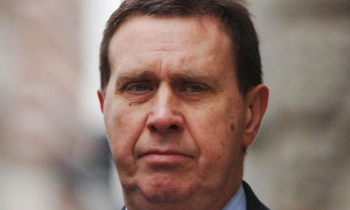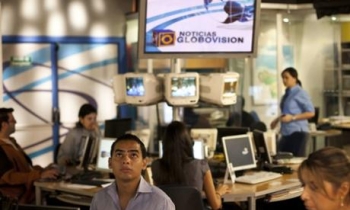Walter Isaacson awoke early at his home in Bronxville, New York, fifteen miles north of Manhattan in Westchester County. Idly, the editor of Time flipped on an all-news radio station. That's when he learned that his seventy-seven-year-old magazine, and indeed all of Time Warner -- the world's biggest media company -- was being enfolded in the embrace of fifteen-year-old America Online, the arriviste 22-million-subscriber gateway to the Internet. Fortune's top editor, John Huey, got the word around the same time: he overheard a fellow passenger's amazed reaction to the story on a plane between Atlanta and New York. Henry Luce III, son of Time's founder, was driving in to New York that morning when a friend imparted the astounding news in a cell phone call. Hours earlier, at about 3 a.m., The Wall Street Journal had moved the story on its Dow Jones wires and onto its Web site, and before dawn, WSJ reporter Kara Swisher was on CNBC (competitor to Time Warner's own CNNfn) giving early-rising cable-watchers their first whiff of one of the most startling media stories in U.S. history.
At about 7 p.m. on the evening before, Norman Pearlstine, editor in chief of Time Inc.'s thirty-three magazines (plus book clubs, book publishing, Internet sites, direct marketing) had heard about the impending corporate nuptials for the first time. "My initial reaction was to be pissed off that the news hadn't broken on a Thursday, because we had closed Fortune on Friday night and Time on Saturday night." He didn't alert Isaacson, Huey, or any of his other editors. "When I got the news, the management of both companies had reached an agreement in principle, but it had not yet been put to a vote of either board. Having no magazine to put out for another two or three days, I treated the story as something I was told on a confidential basis. My instinct was to keep it to myself at that point. If Time went to press on a Sunday night, I would have reacted differently."
Astonishingly, no hint of the deal had reached the public ahead of that formal announcement on January 10, even though AOL boss Steve Case and Time Warner chief Gerald Levin had been meeting and talking about it for months; and dozens of executives, lawyers, and brokers (from Salomon Smith Barney, and Morgan Stanley Dean Witter) had worked vigorously to thrash out the details. Legions of business reporters at Time Inc., CNN, and CNNfn were not favored with any advance, inside information -- and couldn't have used it anyway without inviting the curiosity of federal regulators for possible stock tampering.
And so began on January 11 in the world's newspapers, magazines, and electronic media a panoramic effort to root out "what this deal is really all about." Journalists groped for phrases to epitomize it: "The triumph of the Internet as an irresistible force"; "The prototype for a twenty-first century media colossus"; "The beginning of the end of the old mass media"; "Stunning! Wow! Bingo!"; "A gripping transitional moment in history"; "The death of old media"; "One of those events that have the potential to change the competitive landscape so fundamentally that nothing can be the same again." The Wall Street Journal expressed its astonishment that a company "not old enough to buy beer" had essentially swallowed a mature media conglomerate that took most of a century to construct. The Economist offered an uncharacteristic, garish movie-poster cover: "AOL Time Warner presents: the big leap . . . when new media comes of age . . . The most talked about deal in history!" Steve Case contributed to the hip-hooray and ballyhoo: "This is a historic moment in which new media has truly come of age . . . .We are going to be the global company for the Internet age . . . .This will be the Internet Century . . . ."
In simplest terms, AOL and Time Warner had thrown each other a life preserver in the effort to grow rationally in the new millennium. One of them needed more products on its shelves to increase its appeal to customers, and the other needed (after failed, fumbling attempts to construct it) a thruway to those millions of online eyeballs. Between them they could eventually offer fast, virtually instantaneous hook-up to the Internet over upgraded cable lines, and thus sell more of everything than either could alone. And they'd be poised to offer the folks at home television, telephone, and Internet service in one package with one handy monthly bill.
Very quickly and inevitably, the word "journalism" popped up, and another round of hand-wringing began over the profession's plight. It all started fifteen years ago with the first great round of mergers that saw NBC News absorbed by GE, ABC News devoured by Disney, CBS News subsumed into Viacom, Time Inc. wedded to Warner Brothers, and CNN ingested by Time Warner.
It was déjà vu all over again, as consumerists, academics, and journalists browsed on the familiar questions: Will three or four gigantic companies soon control all media? Are news people losing their independence and being drowned in the tidal wave of consolidations? Is public confidence in the press being eroded as journalists are suspected of downplaying bad news about their owners and cheerleading for the good news? Is the invisible cancer of self-censorship metastasizing in journalism's bones?
Levin had anticipated all such conundrums because he'd faced them in 1990 when Time Inc. joined Warner Brothers. He informed Case in their earliest merger talks that the editorial independence of Time Inc. and CNN was an essential ingredient of the deal. "My DNA is related to the practice of first-rate independent journalism," he told Jim Lehrer on The NewsHour when he and Case appeared together on January 12. "The whole history of taking Time Inc. into its current state, and now with AOL, has been designed to protect and enhance the journalistic independence of our company."
To that, Case offered his view that "it's important to really empower journalists to do their job, and the whole thing unravels if there is any question about that." The new AOL/Time Warner would almost surely get tougher coverage from in-house journalists than from outsiders, he insisted. They will "bend over backwards" and be more "negative" in covering the parent company. "This is not about trying to have some influence over all these media properties for some kind of self-serving reason."
But no amount of such fervent assurances has been sufficient to allay the fears of news theorists and practitioners who recall such mischief as Disney killing an embarrassing ABC News report about hiring practices at Disney World. (Or Michael Eisner's memorable, worrisome remark: "I would prefer ABC not cover Disney. I think it's inappropriate for Disney to cover Disney.") Or Rupert Murdoch's expunging the BBC from his Asian satellite service to curry favor with the Chinese. Or CNN, during the debate over the 1996 Telecommunications Act, refusing to run phone companies' commercials that claimed cable rates would zoom if the bill passed.
Time Inc.'s Pearlstine spends as much time thinking about such issues as anybody in the profession. The marriage with AOL is "incremental, rather than some great sea change," he feels. "We survived the merger with Warner. We survived the merger with Turner. So I don't see any real downsides in terms of coverage -- just more of it." Three years ago, he rewrote his own job description to state that part of his mandate is to cover his own division and the rest of Time Warner in equitable fashion. "I think we're actually pretty good now at being critical of ourselves. We're sort of past that." The trickier task, he thinks, is to publish a legitimate, laudatory piece about some aspect of AOL/Time Warner's business. When some good-news story about the company breaks, "will we have the self-confidence to write it," he asks, "knowing that the Columbia Journalism Review will be jumping all over us for touting our corporate parent? My hope is that the answer to that is yes." Time recently published a cover on the Pokémon phenomenon while Warner Bros. was releasing Pokémon: The First Movie. Pearlstine claims that not to have put Pokémon on the cover "would have been strange, given how ubiquitous the stuff is," even though the article was one more example, among several, of Time Inc. bestowing cover stories on Time Warner products such as Stanley Kubrick's film Eyes Wide Shut.
The Time Inc. sibling most intimately affected by formation of the new, extended family is Fortune, since a huge percentage of its articles are about some AOL/Time Warner ally or competitor, or relate in some marginal or crucial way to the parent's interests. Fortune media columnist Marc Gunther, speaking shortly after the merger announcement, said that his experience at the magazine so far has been "exemplary," but he's concerned about public perception, both past and future. He was finishing up an AOL piece "which continues to reflect my belief that they're a really good company run by smart people. I'm sure there will be readers who'll say, 'He's a shill for the parent company,' and that bothers me. No matter how well you run these publications, people are going to be suspicious, and I don't know if there's anything that any of us can do about that."
Similarly, The CNN News Group's portfolio requires that it cover media and dot-commerce for its 76 million U.S. subscribers and more than a billion people in 212 countries and territories. What does the new alignment mean for CNN journalism? "I haven't a clue," says Jeff Greenfield, the network's senior political analyst and veteran media observer. But he doesn't share the alarm of some critics. Bad journalism doesn't turn on who owns you, he thinks. "In some ways, big is an advantage to journalistic independence." A small town editor who attacks his publisher's pal, the mayor, can be in deep trouble, whereas big media can often tweak the powerful, and be resilient enough to withstand retribution.
Nonetheless, the biggest dilemma that such giant mergers pose for journalists, Greenfield confesses, is that by definition they enlarge the likelihood of corporate tinkering. As a company's universe expands, so does the risk of embarrassment from information reaching the public that might harm profitability or image. "I absolutely agree that bigger aggregates of corporate size increase the potential for conflict of interest. OK -- now you've said that, now what?" The only course then is to keep a keen eye out for corporate interference. "If AOL/Time Warner starts mucking around with the editorial decisions of CNN, a lot of us would say, 'No thank you, we're not sticking around.'" Two clichés apply, Greenfield says: "The proof is in the pudding," and "By their fruits you shall know them."
Journalism is expensive -- not nearly so profitable as entertainment. The argument can be made, says media theorist Esther Dyson, that the bigger the company the more money for its journalists to do their jobs. "I don't think this merger changes things much. It recognizes the changes that have already occurred with regard to how the media work." The only real positives she sees for journalism is that Time Warner "gets a new lease on life -- more excitement."
But bigness is a contagion in the new age of mega-media, and the AOL/Time Warner deal makes more likely another round of consolidations, and yet more head-shaking about the plight of journalists trapped in ever more mammoth corporate edifices. Disney, Viacom, GE, News Corp., Sony, Bertelsmann? Who'll make the next defensive move? What surprises might we expect from Gannett, Times Mirror, Dow Jones? When the dust clears in a few years, will a handful of companies dominate an integrated, global commercial communications market?
More immediately: Will AOL/Time Warner allow other, smaller Internet service providers nondiscriminatory open access to its system (as most media experts are demanding), thereby helping assure a diversity of voices? Or will it use its size and ubiquity for unfair advantage? (The company claims it will take the high road, without bureaucrats forcing it to do so.)
Still, AOL subscribers may expect in the future -- not surprisingly -- to see Time Inc. businesses appear more prominently than ever on their computer screens: People, Sports Illustrated, Parenting, Cooking Light, Progressive Farmer, Southern Living, In-Style, the Book-of-the-Month Club, CNN, CNN.com. Subscription offers for Time Inc. magazines will proliferate. All manner of Time Warner/AOL-related options and branded services will pop into view onscreen, expects Consumer Union's Gene Kimmelman. "It's giving you a nudge to use their products and services, and to get your information from their journalists." But the merger could be a net gain for consumers, if it isn't allowed to stifle full development of the Internet, he says. "If competitors have fair use of AOL/Time Warner's transmission system, I think there's certainly an opportunity for offering more benefits of innovation."
Making the incipient AOL/Time Warner synergy real will place additional pressures on Time Inc. and CNN journalists to raise profits, according to Robert W. McChesney, professor of communications at the University of Illinois and author of Rich Media, Poor Democracy. The corporate chiefs "won't have time to horse around worrying about whether cjr thinks they're breaching some journalistic code. They've got to make serious coin." AOL has assured investors that the new mega-company in its first year will add an extra billion dollars in pre-tax operating profits. To meet a goal like that, will AOL/Time Warner hand advertisers and marketers a far more significant role in the planning and presentation of editorial product? Most online banner ads aren't highly efficient, so publishers may find new ways of melding advertising with editorial in subtle and not-so-subtle ways. "There are editorial people of great integrity who will resist that, but there will be others who'll go with the flow," says McChesney.
Thus, the firewall debate gains new currency with the AOL/Time Warner deal and others certain to follow. Several experts cjr talked to feel that economic pressures on newsrooms everywhere will be more relentless than ever in the years ahead. Each new amalgamation puts a heavier burden on journalism to perform as a conventional business, says Marvin Kalb, executive director of the Shorenstein Center's Washington office. But newsgathering may not make money, even as it delivers a necessary product for the American people. "There's going to be less tolerance of that in an organization as large as AOL/Time Warner." Ray Cave, former editor of Time, says he's not sympathetic with journalists "moaning and complaining" about these deals. "I think the real responsibility of journalists is to realize: this is the world we now live in." And then: how to do the best possible job in circumstances that are not ideal, but which are inescapable.
At the heart of the AOL/Time Warner concordat and the issues it raises for journalism is the explosive evolution of the Internet. As recently as 1990, most Americans hadn't heard of it. Now, 200 million people worldwide are online and that number will reach a billion in the next half-dozen years. The World Wide Web was virtually unknown until 1995. That same year, Bill Gates in a famous internal memo ordered his executives to make the Internet the focus of Microsoft's planning for the road ahead to the new millennium. Most of the nation's 1,500 daily newspapers and 18,000 magazines now have Web sites, almost all of which are money-losers so far. National news organizations recognize that a rich, utile online presence is essential to their competitive success. Soon, the gargantuan cable companies like AT&T and AOL/Time Warner will have replaced their puny, low capacity wires with hugely capacious "broadband" pipelines -- great aqueducts funneling news and information to homes and businesses in heretofore unimaginable volume and variety.
The building of that priceless infrastructure is inevitably wedding power to power. Many journalists are finding themselves ever smaller potatoes in a larger and larger stew -- and looking about, they see fewer stews than ever before on the media cookstove. And yet -- information sources have proliferated wildly since the Big Media era began a decade or more ago: national, and local, all-news cable channels and loss-leader all-news Web sites underwritten by media conglomerates. MSNBC and MSNBC.com, for example, owe their young lives to parents GE and Microsoft. Slate, a first-rate addition to the national discourse (like Salon and comparable Web zines), is another Microsoft offspring. The four-year-old, 24/7 Fox News Channel and The Weekly Standard grow out of News Corp.'s rich loam. CNN operates six cable news networks, a gain of two since its absorption into Time Warner. New York 1, Time Warner's local cable channel, airs municipal news, sports, and weather around the clock as do scores of other such services supported by major cable companies.
The bottom line? There are two: Big deals like the AOL/Time Warner union can be a net gain for consumers by bringing them more and better news sources than ever before. And: journalists down in the trenches need to defend their craft and its principles like wildcats whenever Big Daddy's self-interest collides with telling the whole truth.
Beyond that? Well . . . welcome to the Internet Century!









